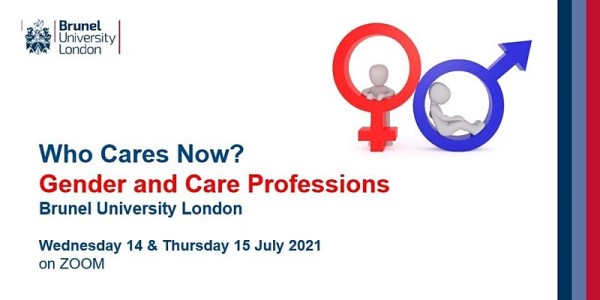The Athena Swan group, in the College of Health, Medicine and Life Sciences at Brunel, supported by colleagues from the divisions of Psychology and Education were pleased to organise a 2-day online conference titled “Who Cares Now? Gender and Care Professions” on 14-15th July, looking at issues around gender in the care professions, including nursing, social work, sign language interpretation and early years education. Academic researchers, practitioners and advocates discussed how gender affects areas as diverse as recruitment, promotion, pay and well-being, and examined the intersection of gender with race, ethnicity, class, age, ability and more. So, is there a glass ceiling and a glass escalator? And why is there such a gap between applications and offers, for men of different ethnicities?
A keynote lecture by Professor Lynne Segal, from the Care Collective set the scene in helping us to consider care, in the context of lack of care from higher levels early in the COVID pandemic, the growing social and economic inequalities, the burgeoning care home crisis, and removal of help to study nursing. She also raised the need to look beyond hands on care from the health professions, to a wider definition of care where we recognise interdependence of one another. View the opening remarks and key note lecture.

The subsequent session on whether care professional’s gender mattered and how we might create a more gender balanced workforce, kicked off with a joint presentation by Dr Kate Clayton-Hathway and Rachel McIlroy. They called for a re-evaluation of the nursing profession, in the light of COVID-19, to make it more sustainable and engender revived interest within an adaptive working environment conducive to women’s split responsibilities. The alternative risks an exodus from the profession. Dr Gary Clapton took up the baton from the perspective of young men’s entry into child care, and why the preponderance of female focussed pictures in the media, does not encourage recruitment in this area. Kate Simpson then discussed a study on the experiences of men who work in nursing and where they may be discouraged from looking after certain types of patient, yet seem to be only too welcome when some extra physical strength is required. We discovered that in terms of disparity, only 3% of speech and language therapists are male, and 10-15% of those who work in nursing are nurses. View session 1 presentations.
After lunch, our speakers continued on the theme of gendered journeys and perspectives. Paul Michaels looked at sign language interpretation as a caring profession from the male perspective, rather than purely a linguistic profession. Twenty percent of the profession are male, and while some emphasise the linguistic basis, others see caring aspects as being an enhancement, enabling interpreters to advocate for and empower the deaf person. Dr Simon Brownhill explored the efforts of partners to build a mixed gender workforce in the Early Years sector, yet acknowledged, in the light of only 2% or this workforce represented by men, in England, a 50:50 gender balance may be difficult to aspire to. It was ‘’not just quantity, but quality” which was needed. He looked at recruitment challenges, together with ongoing, rather than one-off initiatives to widen recruitment. Lewis Fogarty closed the session and the day with a look at masculine and feminine leadership in Early Childhood, emphasising that leadership needs to be child centred, empathic and staff-centred, leading from the centre, not the top of a hierarchy. Caring need not equate to non-professional, and gender can be “a tool for change”, breaking down stereotypes by having a mixed gender workforce. View session 2 presentations.
Day 2 of the conference commenced with a session focussing on the need to support both women and men in care professions. Vivienne Porritt and Dr Deborah Outhwaite described the work of a global movement of local networks, #WomenEd, aiming to make women 10% braver and empower them to have the choice to progress in their leadership journey. They looked at what women can do to address what they see as limitations, how movements such as ‘He for She’ can provide support, and what enablers society needs to put in place in addressing the gender pay gap, and normalising part-time roles for men, releasing them to share childcare. Dr Iritza Quereshi then highlighted intersectionality of gender and ethnicity, by looking at the barriers for British South East Asian men in nursing, even in a Covid-19 exacerbated environment of a 40,000 deficit of qualified nurses in the UK. While not underrepresented in applications, they are less likely to be accepted for courses, and are subjected to greater attrition. View session 3 presentations.
Following lunch, the focus turned to experiences and challenges of male students on ‘feminine’ professions courses. Dr Jason Schaub described opposing phenomena of men’s privilege which results in men dominating in academia and managerial posts in social work (although overall a women majority profession), and yet the stigma in men carrying out what is perceived as ‘women’s work’, which results in an ever decreasing proportion of male students in social work courses, with greater attrition. Dr Schaub critically evaluated various arguments for why more men are needed in social work. Danica Minic explored the barriers to male participation in nursing and allied health professions and the identification of gender specific or gender-neutral marketing messages, including imagery, which would encourage entry into these courses. Not all allied health professions had the same difficulties! Dr David Galley finished the session with an in-depth analysis of the voices of male students entering social worker, concentrating on the intersectionality of gender and sexuality. Finally, Dr Wendy Martin chaired a panel discussion compromising Dr Laura Hills for the staff perspective, and Niamh Coyle for the student view. At Brunel, the College of Health, Medicine and Life Sciences, does indeed have a majority of females students except for Sport, Health and Exercise Science. View session 4 presentations.